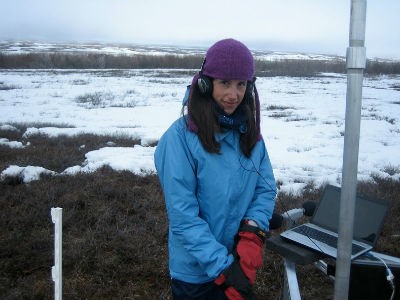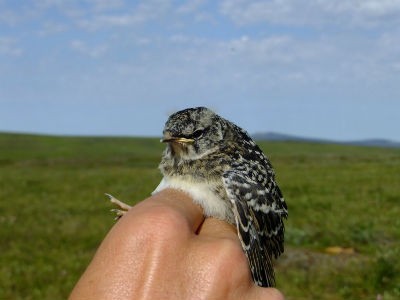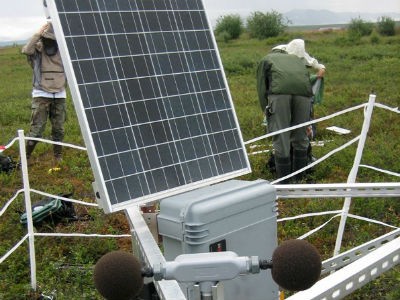In a Warming Arctic, Listening for Birds

Millions of songbirds flock to the Far North each spring, lured by an abundance of food and a relative lack of predators. Over five breeding seasons, Natalie Boelman recorded their chatter from several remote outposts on Alaska’s North Slope. Her goal: to understand how songbird breeding habits may be changing as the Arctic warms two to three times faster than the rest of the planet.
With 2,200 hours of recordings now in hand, Boelman, an earth scientist at Lamont-Doherty Earth Observatory, has teamed up with Dan Ellis, a speech recognition expert at Columbia Engineering, to analyze the data. A two-year $200,000 grant from the Data Science Institute, meant to foster collaboration in the natural and computational sciences, is supporting their work.
“The data is opaque, but with a computer you can make a plot to see what’s happening with the birds,” said Ellis. “Suddenly the whole picture emerges.”
Far flying and too small to tag with GPS receivers, songbirds are a challenge to study in the wild. In a novel approach, Boelman and her colleagues set out microphones to let the birds come to them. From the foothills of Alaska’s Brooks Range, four microphones recorded at regular intervals from early May through July, over five seasons, starting in 2010. In the 1.7 terabytes of data captured, the researchers hope to pin down when the birds are arriving, and whether the mix of species is changing.
One important factor is how climate change is altering Arctic vegetation. The plants that songbirds encounter when arriving up north influence where they decide to nest and reproduce. White-crowned sparrows prefer woody shrubs, while Lapland longspurs favor open grasslands. As shrub habitat pushes north amid warming temperatures, sparrows may eventually outcompete longspurs and other birds that favor open tundra.
By 2050, Boelman predicts that shrub habitat will expand by between 20 and 60 percent, with an equivalent loss in open tundra. As she and her colleagues analyze the bird recordings, they will listen for a shift in the numbers of sparrows and longspurs coming to breed. They will also listen for signs that the birds are breeding earlier as spring arrives earlier. “The recordings will tell us when which species are arriving and if that changes year to year,” she said.

The recordings may also reveal whether birds once put off by the Arctic’s harsh conditions are now flying in. “We might discover that more typically southern species are moving in as warming continues, and that they favor a shrubbier tundra, too,” said Boelman.
For the past year, Boelman’s graduate student, Ruth Oliver, has sorted through the data to distinguish bird chatter from a cacophony of other sounds, including wind, trucks, buzzing insects and falling rain and snow. So far, Oliver has parsed one microphone-worth of data into 100,000 clips of four-seconds each—the approximate length of a bird call. Using statistics and machine learning, Oliver has grouped those clips into 100 sound types, including bird sounds.

She has three more microphones of data to process but already some trends have emerged. By the second or third week in May, bird sounds emerge as the dominant sound type, she said, consistent with field observations. In years when the snow is slow to melt, somehow the birds know to show up later. When snowmelt was delayed by about 10 days, the birds showed up at the study site about four days later than in years with average weather conditions, said Oliver.
In the second phase of the project, the team will develop an algorithm to pick out individual species, bird by bird, under a range of conditions. Mating songs can vary within species and all songs sound differently depending on the local environment, including weather.
“A robin’s song may sound very differently depending on the context,” said Boelman. “The challenge is to grab the core elements of its song.”
By automating the analysis of acoustic data, the project will make it easier and cheaper to observe songbirds across the Arctic and other wild places globally. It could also allow researchers to monitor other small, vocal animals like crickets and frogs.
It could also help in tracking our own behavior. As Fitbit and other quantified-self platforms track more of our movements, background sound represents a potentially valuable data stream. “It could be any environment,” said Ellis. “Ambient sound is extremely informative.”
Further Reading:
Arctic Researchers Race to Uncover Effects of Global Warming on Songbirds, Audubon magazine, September-October 2013.
Eavesdropping on Arctic Birds, Natalie Boelman featured in a five-part New York Times’ Scientist at Work blog, June 2011.